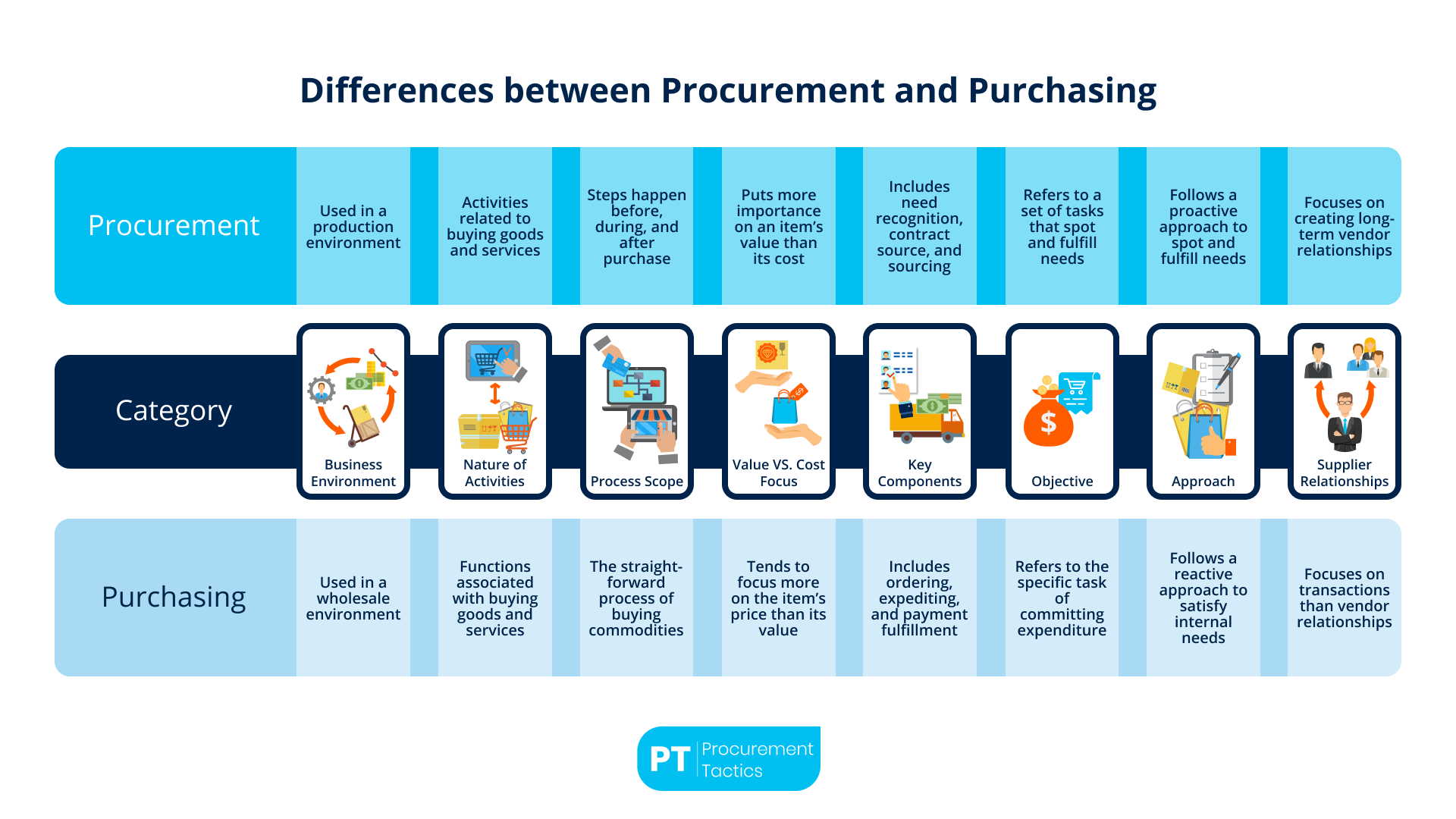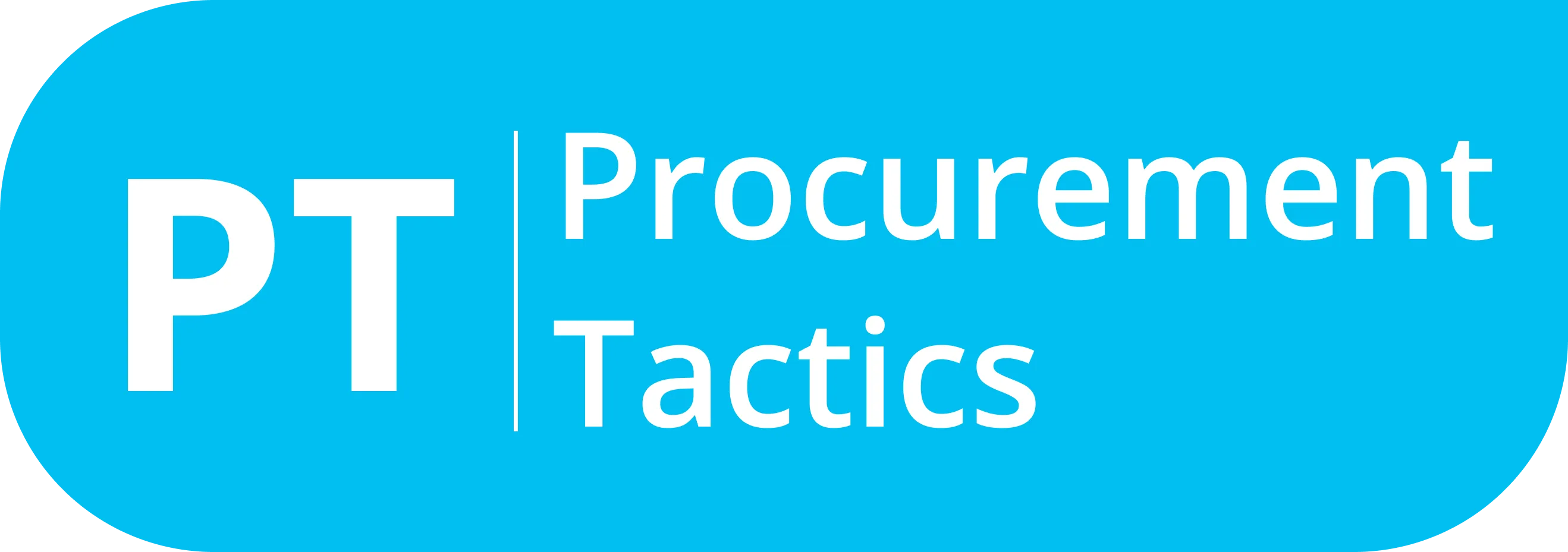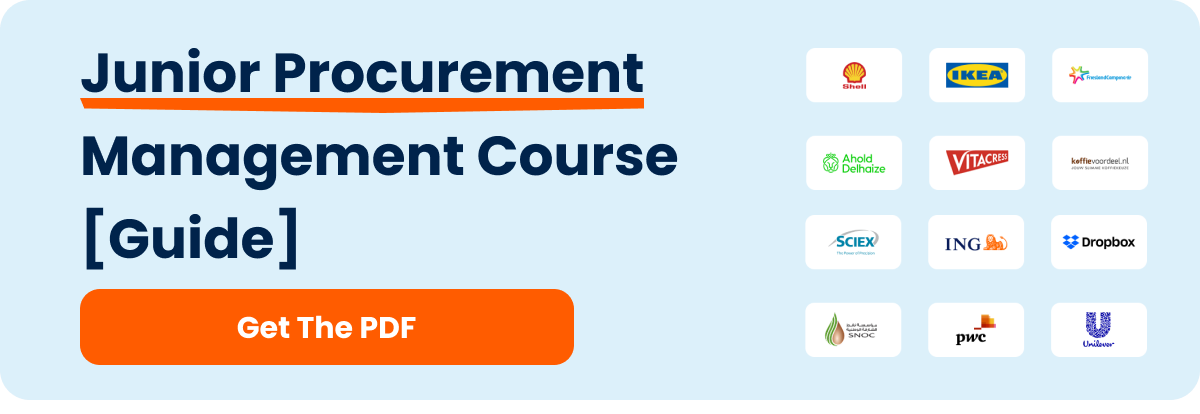Written by Marijn Overvest | Reviewed by Sjoerd Goedhart | Fact Checked by Ruud Emonds | Our editorial policy
Procurement Vs. Purchasing — 5 Important Differences

As taught in the Spend Analysis Course / ★★★★★ 4.9 rating
What is procurement and purchasing?
-
Procurement and purchasing are connected but have different functions in acquiring goods and services.
-
Procurement is more focused on value and managing supplier relationships. Purchasing is transaction-based and prioritizes cost and immediate needs.
-
Understanding these differences and how they complement each other is vital for effective supply chain management.
5 Key Differences Between Procurement and Purchasing
Here are some key differences you may want to know about procurement and purchasing. Keep these in mind the next time someone asks you what the difference between procurement and purchasing is!
1. Analytical vs Strategic
Procurement: A strategic function that focuses on key aspects such as finding the right supplier, maximizing contract value, and ensuring that all goods are received on time. Many view procurement as strategic because it plays a crucial role in optimizing costs, supplier relationships, and overall business efficiency.
Real-life example
Amazon’s procurement function is highly strategic, ensuring efficiency, cost optimization, and supplier relationship management to support its massive global operations. For example, Amazon negotiates long-term contracts with major logistics providers like UPS and FedEx to secure cost-effective shipping rates and guarantee delivery speed.
Additionally, the company leverages data analytics and AI to predict demand and adjust procurement strategies accordingly, reducing overstock and supply chain disruptions.
Purchasing: A tactical function focused on the transactional aspect of acquiring goods and services. It begins with placing an order and ends with receiving it, which is why it is often viewed as a short-term, execution-focused process.
Real-life example
McDonald’s purchasing function is highly tactical, focusing on acquiring ingredients and supplies efficiently to maintain operations across thousands of restaurants worldwide. For instance, each McDonald’s restaurant follows a standardized purchasing process to order fresh produce, packaging materials, and other essentials from pre-approved suppliers.
The purchasing team ensures that daily orders are placed based on sales forecasts and that ingredients are delivered just in time to maintain food quality and minimize waste. Unlike procurement, which involves supplier selection and long-term strategy, purchasing in McDonald’s is more focused on immediate needs and transactional efficiency.
2. Focus
Procurement: Prioritizes value creation, cost savings, contract compliance, risk mitigation, and supplier relationship management, making it a more strategic function.
Real-life example
Apple’s procurement function is highly strategic, focusing on value creation, cost savings, contract compliance, risk mitigation, and supplier relationship management to maintain its dominance in the tech industry. For instance, Apple strategically secures long-term contracts with key suppliers like TSMC for semiconductor chips, ensuring access to cutting-edge technology while mitigating supply chain risks.
The company also invests in supplier sustainability initiatives, requiring partners to adhere to strict environmental and ethical standards, reinforcing its brand reputation and long-term business success.
Purchasing: Focuses on the cost or price of goods and services, aiming to minimize expenses and ensure efficient transactions.
Real-life example
Walmart’s purchasing function is tactical and primarily focuses on minimizing costs, securing low prices, and ensuring efficient transactions to maintain its reputation for everyday low prices. For example, Walmart negotiates bulk discounts with suppliers and leverages its massive buying power to drive down costs on products like household essentials and groceries.
The purchasing team ensures that inventory is replenished efficiently in stores and distribution centers, optimizing restocking processes to prevent shortages while keeping costs low. Unlike procurement, which involves strategic supplier management, Walmart’s purchasing approach is centered on transaction efficiency and immediate cost savings.
3. Supplier Relationship
Procurement: Supplier relationships are crucial, as they enable suppliers to become valuable strategic partners, enhancing long-term collaboration and maximizing value.
Real-life example
Toyota’s procurement function emphasizes strong supplier relationships as a strategic advantage. Rather than treating suppliers as mere vendors, Toyota fosters long-term collaboration, ensuring quality, innovation, and cost efficiency through its Just-in-Time (JIT) system and lean manufacturing principles. For example, Toyota closely collaborates with key suppliers like Denso and Aisin, sharing production forecasts and engaging in joint innovation projects to continuously improve product quality and efficiency.
This long-term partnership approach not only reduces costs but also enhances supply chain resilience, enabling Toyota to quickly adapt to changing market conditions and technological advancements.
Purchasing: Building strong supplier relationships is almost non-existent, as it focuses only on working with the current supplier base to acquire the necessary goods and services.
Real-life example
Fast-food chains like McDonald’s and KFC operate with transactional purchasing models, where supplier relationships are not the priority. Instead, the focus is on efficiently acquiring necessary goods and services from existing suppliers to maintain daily operations. For instance, McDonald’s works with multiple pre-approved suppliers for ingredients such as potatoes, buns, and meat, ensuring a steady supply while prioritizing cost efficiency and speed over long-term strategic collaboration.
If a supplier fails to meet cost or delivery requirements, the company can quickly switch to another approved vendor without significant disruptions. Unlike Toyota, where suppliers are deeply integrated into the production strategy, McDonald’s purchasing model remains highly transactional and focused on operational efficiency.
4. Complexity
Procurement: A more complex process involving multiple steps and decision-making. It extends beyond purchasing by requiring ongoing supplier performance monitoring even after contracts are completed, making it a continuous and strategic function.
Real-life example
Boeing’s procurement process is highly complex and strategic, involving multiple decision-making steps, supplier evaluations, and continuous performance monitoring even after contracts are signed. For example, Boeing collaborates with hundreds of suppliers worldwide to source specialized components for aircraft production, such as advanced avionics, composite materials, and engines from companies like General Electric and Rolls-Royce.
The procurement team conducts rigorous supplier audits, quality checks, and risk assessments to ensure that all components meet strict aviation industry standards. Even after a contract is signed, Boeing continuously monitors supplier performance, adjusting sourcing strategies to mitigate risks like supply chain disruptions, material shortages, or regulatory changes. This long-term and multi-step approach highlights the complexity of procurement in industries with high safety and quality requirements.
Purchasing: A simpler process with fewer stages. Once the required goods or services are bought, the process is complete, making it more transactional and short-term focused.
Real-life example
Zara’s purchasing function is simple, transactional, and short-term focused, ensuring that required goods (e.g., fabrics, buttons, zippers) are bought quickly, delivered, and used in production without ongoing supplier monitoring. For instance, Zara’s fast-fashion business model relies on quick purchasing cycles, where raw materials and finished products are sourced from a network of pre-approved suppliers based on immediate production needs.
The purchasing team places frequent, small-batch orders to maintain agility, ensuring that inventory is replenished rapidly without engaging in long-term supplier relationship management. Unlike Boeing’s procurement approach, which involves extensive supplier evaluation and performance tracking, Zara’s purchasing strategy is focused on speed, efficiency, and cost-effectiveness to keep up with constantly changing fashion trends.
5. How Goods or Services are Evaluated
Procurement: Focuses on the long-term value and usefulness of a purchase rather than just its cost. Procurement managers evaluate whether an investment will lead to cost savings or operational improvements in the future. Even after a deal is completed, procurement continues to monitor performance to ensure ongoing benefits.
Real-life example
Tesla’s procurement function is long-term focused, ensuring that investments in raw materials, technology, and suppliers lead to cost savings, operational improvements, and sustained business growth. For example, Tesla secures long-term supply agreements for critical materials like lithium, nickel, and cobalt to support battery production, reducing dependency on market price fluctuations. Additionally, Tesla evaluates supplier innovation and sustainability—choosing partners who can enhance production efficiency and align with its mission for sustainable energy.
Even after contracts are signed, Tesla continuously monitors supplier performance, adjusting procurement strategies to optimize costs, production quality, and innovation cycles for future growth.
Purchasing: Primarily concerned with the price of goods and ensuring they fit within the budget. The focus is on immediate affordability rather than long-term impact. Once the purchase is made, there is little follow-up on the product’s performance.
Real-life example
The purchasing departments at Walmart and Carrefour are primarily price-focused, ensuring that goods fit within the budget and meet immediate cost requirements. For instance, both retailers use bulk purchasing strategies to negotiate the lowest possible prices for everyday consumer goods, prioritizing affordability over long-term supplier relationships. Walmart’s Everyday Low Price (EDLP) strategy relies on constant price comparisons and supplier competition to keep costs down, while Carrefour frequently switches suppliers if lower-cost options become available.
Once goods are purchased and delivered to stores, there is little follow-up on supplier performance unless issues like delivery delays or product defects arise. Unlike Tesla, where procurement decisions shape long-term business success, purchasing in retail is transactional, short-term, and focused on cost efficiency.
Pro Tip: Understanding the difference between procurement and purchasing is step one. The real value comes when you apply that difference to your spend data. Start by tagging transactions as either strategic procurement or tactical purchasing—this simple split can instantly reveal where your biggest opportunities (or inefficiencies) lie. ⭢ In our Spend Analysis Course, we show you how to do this in practice—turning raw spend into insights that fuel smarter decisions and stronger supplier strategies.
What is Procurement?
For the professional procurement manager, procurement means the process of identifying, shortlisting, selecting, and acquiring needed goods or services from a third-party vendor.
It can be done via direct purchase, competitive bidding, or tendering process while making sure that the delivery of the supplies is done in a timely manner.
What is Purchasing?
Purchasing is an entirely different thing from procurement. Purchasing means a set of functions that are associated with buying goods and services that the company or organization requires.
The only reason why purchasing is often associated with procurement is that it is a small subset of a broader procurement function. In simple terms, purchasing is a part of procurement.
The purchasing process always includes ordering, expediting, receiving, and fulfilling payment.
The Procurement Process
As explained, the procurement process is the process of sourcing a product or a service. So for the procurement manager, there is a set of rules and processes that need to be followed in order to build the procurement process.
A typical procurement process is usually divided into the following steps:
The Purchasing Process
To put it simply, purchasing needs. Those products/services do not affect the growth of the company but are rather just needed for its continuous operations.
Does that mean that the procurement manager won’t bother with creating a purchasing process?
The answer is a big no. A procurement manager recognizes the importance of creating a purchasing process since it enables the company to achieve short-term goals that include timing, costs, and quantity.
The typical purchasing process includes the following:
- Evaluating received RFQs
- Creating and distributing purchase orders
- Receiving products/services
- Quality assurance of received service/product
- Receiving a purchase request
- Arranging payment to suppliers
Procurement and Purchasing: Similar and Yet, So Different
In a procurement team, the terms procurement vs purchasing are often used with just one meaning in mind. Both of the terms are often associated with buying supplies or materials that probably no one cares about defining each term properly. But for a good procurement manager, distinguishing purchasing from procurement is an important skill.
The Procurement and PurchasingDefinition Table
To help procurement managers with setting definitive qualities for procurement and purchasing, we at Procurement Tactics created a simple table for such a need.
More definitions and terms are available for interested procurement managers in our Negotiation Course For Procurement Professionals.
So if we were to create a small and simple table for defining procurement and purchasing, it’d go about something like this:

Examplesof Procurement and Purchasing
Although there are many types of procurement and purchasing, they both have one thing in common: to acquire the best product or services for the best possible price. Here are some examples of how procurement and purchasing are done:
This process is where suppliers submit their bids to provide goods and services. Thus, the government or a company chooses the bid that matches their requirements.1. Competitive Bidding
2. Sole Sourcing
This process happens when there is only one supplier who can provide for the needs of the company.
3. Open Market
This happens when a company purchases goods or services from the open market without any restriction to suppliers who can provide for its needs.
4. Request For Proposal (RFP)
This document is issued when a company or the government wants to purchase goods or services but there are many suppliers who can provide for their needs.
Thus, the suppliers submit their proposals, and the company or the government will choose the proposal that matches their requirements.
5. Reverse auction
In this process, suppliers compete against each other to offer the lowest price for their goods and services. The company will choose the supplier who has the lowest price.
Conclusion
Just like we discussed earlier, procurement is about finding and getting things a company needs, like products or services. On the other hand, purchasing is a smaller part of this, where you actually buy the stuff.
So, procurement is like the big plan for managing everything the company needs, while purchasing is about getting those specific things.
Now that you get the difference between procurement and purchasing, we hope it’s clearer for you to see how they each play their own important role in making sure a company has what it needs.
Frequentlyasked questions
What is the difference between procurement and purchasing?
Procurement is a strategic process focused on selecting suppliers, managing contracts, and building long-term value, while purchasing is more transactional and deals with acquiring goods or services. Essentially, procurement involves broader planning, and purchasing handles the execution of those plans.
What is procurement in business?
Procurement refers to the strategic process of sourcing goods and services from suppliers, ensuring value, and managing supplier relationships. It involves steps like negotiating contracts and evaluating supplier performance.
What does purchasing involve?
Purchasing involves the transactional activities of buying goods or services needed by the company, such as issuing purchase orders and processing payments. It focuses on the cost and delivery of goods within a shorter timeframe.
About the author
My name is Marijn Overvest, I’m the founder of Procurement Tactics. I have a deep passion for procurement, and I’ve upskilled over 200 procurement teams from all over the world. When I’m not working, I love running and cycling.






